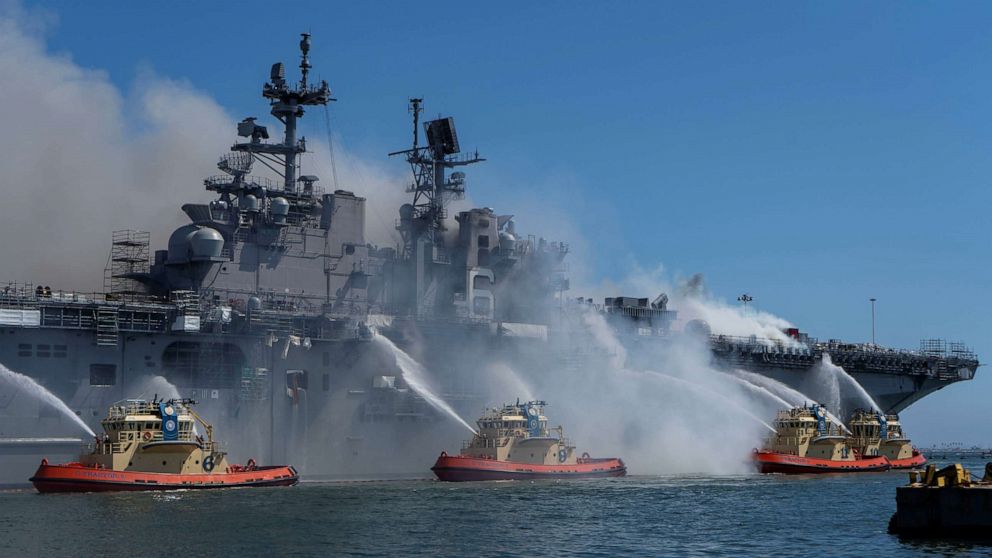


More than 400 sailors are working to put out the massive fire that continues to rage aboard the USS Bonhomme Richard in San Diego and Navy officials are unclear how long the blaze might continue to burn.
The fire has brought down the amphibious assault ship's forward mast and caused other damage to the ship's superstructure that rises above its flight deck.
"There is a tremendous amount of heat underneath and that's where it's -- it's flashing up -- also forward, closer to the bow again there's a heat source and we're trying to get to that as well," Rear Adm. Philip Sobeck, the commander of Expeditionary Strike Group 3 said at a news conference Monday in San Diego.
Sobeck said that the temperatures in the fire's heat sources are reaching as high as 1,000 degrees. With temperatures that high, the sailors are rotating in on 15-minute firefighting shifts.
MORE: Officials investigating after 21 sailors, civilians hospitalized in San Diego naval ship explosionAsked if he believes the ship could be saved, Sobeck said, "I feel absolutely hopeful because we have sailors giving it their all."
He also expressed confidence that the fire will not get close to the ship's supply of one million gallons of fuel, which lies two decks below the blaze.
The fire continues to cause damage to the the ship's superstructure, which rises above its flight deck and has brought down one of the two masts that tower above.
Sobeck acknowledged that the ship's Halon fire suppression system -- which could have put out the initial fire -- was not activated because it was also receiving maintenance.
"We again augment that with firefighting elements from the pier and the shipyard," said Sobeck.
Teams of sailors were pouring water onto the ship from the pier and from tugboats along its side. Navy helicopters have also dropped 415 buckets of water on the ship to contain the fire, much as they have done in the past to help put out wildfires.
There were 57 sailors injured after the fire started aboard the ship on Sunday, most have been treated for exhaustion and smoke inhalation. A U.S. official told ABC News that the last five individuals who remained hospitalized have been released from the hospital.
Sobeck had no information about how the fire started, but said it originated in the "lower V" part of the ship's aft section, which normally holds equipment used by Marines when they are aboard the vessel. Since the ship has been in maintenance, it has been used to hold maintenance supplies, including lots of cardboard boxes.
"Because the ship was in the shipyard, there is lots of scaffolding and lots of debris in the way," Sobeck said, explaining that it has hampered firefighting efforts.
He said the initial fire was too much for the sailors aboard the ship at the time, which is why they called for civilian San Diego fire units to assist. But the blaze continued to expand, setting off an explosion aboard the ship.
Addressing concerns in the San Diego community that smoke from the fire may contain environmentally hazardous materials, Sobeck said he was aware that plastics, cabling and rags have burned.
"Right now, we're testing and we're checking everything that we know and we're well within EPA standards," said Sobeck. "There's nothing else on board the ship that would be toxic in nature" aside from the fuel aboard.
"As we continue to fight the fire, we remain conscious of concerns regarding the air and water quality, and we recommend following county advisories for safety out of an abundance of caution," he added.
The U.S. Coast Guard has also contracted for a protective boon to be deployed around the ship to guard against any potential environmental concerns. A one mile nautical and temporary flight restriction zone has also been established around the ship to ensure the safety of firefighters and the public.
Looking much like a smaller version of an aircraft carrier, the USS Bonhomme Richard is one of nine amphibious assault ships in the Navy. When on deployment, the ship carries a variety of Marine aircraft, including tilt-rotor Ospreys, Super Cobra attack helicopters and vertical take-off versions of the F-35 Lightning fighter jet.
The extensive fire damage will leave the Navy with the difficult choice of trying to put the ship back in service -- a process that could take years -- or deciding to take the ship out of commission.